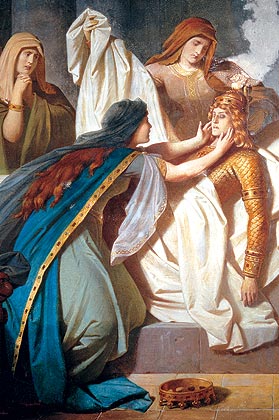J.R.R. Tolkien's
The Legend of Sigurd and Gudrun--his reworking of the Germanic/Norse legends of Sigurd and the subject matter of the Niebelungenlied, the Eddas and others--was published earlier this year to
mostly positive reviews (
but not all). As with all of his father's posthumous works, Tolkien's son Christopher culled and edited notes and rough drafts (including lecture notes given by Prof. Tolkien who was an accomplished academic linguist) for presentation in this book. The younger Tolkien also offers his own editorial commentary on the source material and, most importantly for the historically inclined, provides some of the notes taken by his father concerning the origins of the various legends. Thus, we have J.R.R. Tolkien's own thoughts--the most contiguous presented in the appendices--on the various interpretive problems and it is here that scholars interested in the historical roots of these ancient Northern European works may profit the most.
J.R.R. Tolkien used other legends such as
Widsith and
Beowulf to inform his interpretation of how the stories of the mythical Burgundians may have evolved from history.
[Gunther/Gundahari's] tale is one of downfall after glory--and sudden downfall, not slow decay--sudden and overwhelming disaster in a great battle. It is the downfall, too, of a people that had already had an adventurous career, and disturbed things in the west by their intrusion and by the rise of a considerable power at Worms. It is easy to see how their defeat by Aetius only two years previously [in 452 AD] would be telescoped in the dramatic manner of legend into the defeat by the Huns (if not actually connected in history, as it may have been).
[Gunther/Gundahari], already valiant and a generous goldgiver as patron in Widsith, must have been very renowned. Mere downfall, without previous glory, did not excite minstrels to admiration and pity. However, we are probably not far wrong in guessing that there must--quite early--have been some other element than mere misfortune in this tale to give it the fire and vitality it clearly had: living as it did down the centuries. What this was we can hardly guess. Gold? It may well have been that gold, or the acquisition of some treasure (that later still became connected with some renowned legendary gold) was introduced to explain Attila's attack. Attila (when legend or history is not on his side) is represented as grasping and greedy. It may have been in this way that Gunther/Gundahari ultimately got connected with the most renowned hoard, the dragon's hoard of Sigemund [in Old English], of Sigurd [in Old Norse]. (p.340-41)
There is also a discussion concerning Attila's part in all of this (as Atli) that is interesting and concludes with a summary by C. Tolkien that his father:
...sketched out his view of the further evolution of the Burgundian legend when the story that Attila was murdered by his bride had taken root. Such a deed must have a motive, and no motive is more likely than that it was vengeance for the murder of the bride's father, or kinsmen. Attila had come to be seen as the leader of the Huns in the massacre of the Burgundians in 437 {again, telescoping--ed}; now, the murder was done in vengeance for the destruction of Gundahari and his people. Whether or not Ildico {Attila's bride} was a Burgundian, her role in the evolving drama must make her so . And she avenges her brother, Gundahari.
Tolkien believed that the more mythical legends of Sigurd and the Nibelung horde were intertwined with the historical fall of the Burgundians. He based this on a close reading of Anglo-Saxon poetry, particularly
Beowulf and
Widsith, as compared to the stories as told in Low or High Germany. From his readings, he concluded that the legend of Sigurd was fit into the fall of the Burgundians because both dealt with some sort of gold hoard. He also offers a theory as to how the Burgundians became known as the Nibelungs. In short, it makes for an interesting--if complicated--read.


